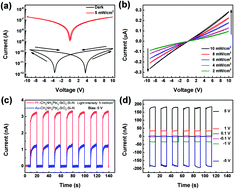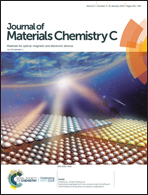Self-powered behavior based on the light-induced self-poling effect in perovskite-based transport layer-free photodetectors†
Abstract
High-performance photodetectors based on organic–inorganic hybrid perovskite single crystals and films have attracted extensive attention recently. In this study, a self-powered behavior was observed in a perovskite photodetector with a special asymmetrical metal/silicon dioxide/perovskite (MOS) structure that lacks the hole and electron transport layers. This self-powered behavior originates from the as-formed built-in electric field within the perovskite film due to the light-induced self-poling effect. The photogenerated carriers are well separated and drift in response to the built-in electric field, resulting in a large photocurrent reaching the nA level without an applied bias. Silicon dioxide acted as a barrier for the carriers, resulting in an ultralow dark current equal to the noise current. This self-powered MOS photodetector exhibited an ION/IOFF ratio of 105 and fast rise and fall characteristics (<30 ms). Our results suggest that exploiting the light-induced self-poling effect in perovskite films offers an alternative for developing reliable self-powered MOS photodetectors.



 Please wait while we load your content...
Please wait while we load your content...